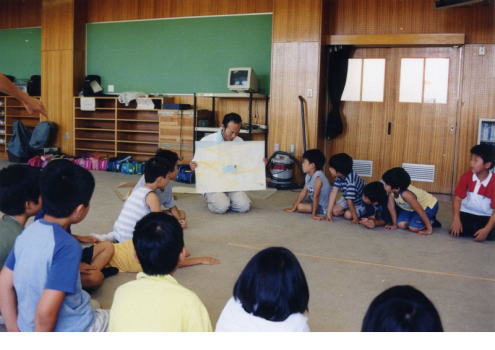|
|
 |
back
|
|
|
|
| Spring in Desert |
| workshop at Sagamihara Municipal Primanry School 2001. |
 |
 |
......First of all, I produced Spring in Desert as a book. While editing dialogues with friends, people in the community,
and my parents, various analogous thoughts and synchronous images occurred
to me. My personal images of water developed into something more universal
and glocalnessh seemed to lead into gglobalness.h
I had to think about how to present the work at Yokohama Tirennale 2001.
I had the feeling that it would be like stuffing and mounting a living
thing. Through I felt it would be meaningful to exhibit a work coming from
a local community at an international event, I also had a strong sense
of incompatibility. Something was missing. When I had the idea of holding
a workshop at my old elementary school, I finally understood where I want
to go with Spring in Desert. By meeting local elementary school children, I was able to integrate
work I had done on various levels into one story in a living environment.
Combing the story with the childrenfs own images made into something living
and vital. Through these encounters with local children I succeeded in
linking together in a complete circle the stories I had heard from the
local elderly people I had interviewed and my own fervent wish as a gnew
residenth (as they called me) to recreate this community where I grew up
as my gnative placeh through a kind of mystical alchemy. I felt that I
belonged not just to the present time but all the times and places related
in local myth told around bonfires by tellers of folktales. Spring in Desert was a document of this circle.
(from Interview with Toshiaki Tomita, Password cat. )
This book titled gSpring in Deserth by Toshiaki Tomita is to be published along with his works for the exhibition
at Yokohama Triennale 2001 (from September 2 through November 11, 2001.)
However, this book is not exactly the same as the catalogue with the same
title for the works exhibited. As the explanation goes, a fieldwork was
done for publishing a book. The place around Oonodai, Sagamihara-Shi, Kanagawa-Ken
is the authorfs hometown, and I returned there from time to time when I
was a college student. I found things quite changed after a long absence,
and at the same time, I found old scenery such as the remains of copses
and irrigation streams where I used to catch insects or make sketches.
They are now green belt and walking promenade to remind us of good old
days. I returned to Japan from the States where I was studying to prepare
for the exhibition and for publishing the book. When I was taking a walk
around my house and came near the primary school, I happened to hit an
idea that I could create some work with children living in the same place
now. The stories folks and parents tell children from their own memories
are the common voices from the past to the future. Then, the children living
in the same place where I used to live can be the other self of mine in
the past and in the future. How wonderful it will be if I could relate
the memories of their land and the vision and let them make sure that there
is a ring to connect the world not only passing through by the experience
of drawing nearby scenery and images! The teachers at Sagamihara Shiritsu
Oonodai Primary School were very friendly and cooperative when I asked
them to help with my idea. They were also preparing a new program to study
and cooperate with their local society. We had a chance to discuss together
to create our works with the third graders before the summer vacation.
(from artist book Spring in Desert)
photo: Asami Tada

|
|
